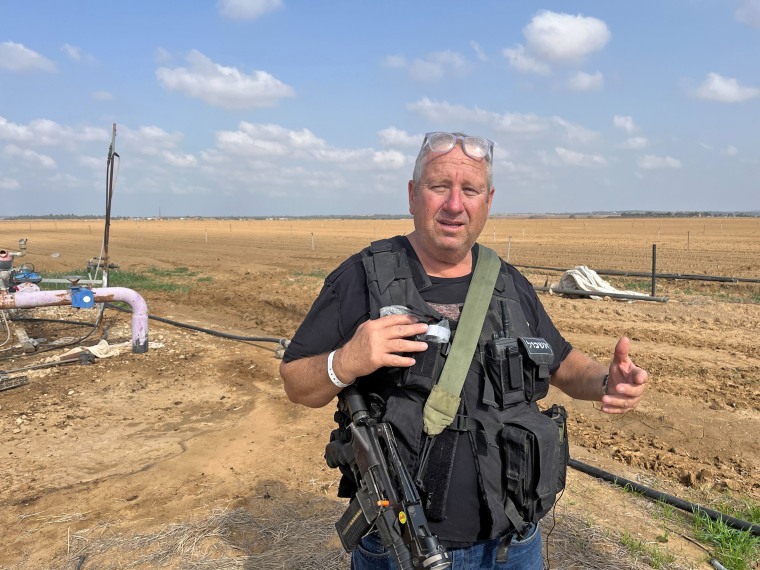KIBBUTZIM RE’IM/BE’ERI, Israel — The tractors that recently dug graves are being prepared to farm again.
Three weeks after the unprecedented Hamas attack in which residents of kibbutzim were tortured and butchered, some survivors are returning in an attempt to rebuild.
Their ability to do so forms a question mark hanging over one of Israel’s foundational movements and whether these collective, often-leftist communities that were central to the establishment of the Jewish state can ever truly recover.
They must try to do so while processing their grief and horror, while the battle raging over Gaza just a few miles away lights up the skies and provides a cacophony of booms and thuds through the night, and while in some streets the stink of death still lingers.
“This was a killing zone,” says Noam Mark, 60, who used to manage the Re’im kibbutz.
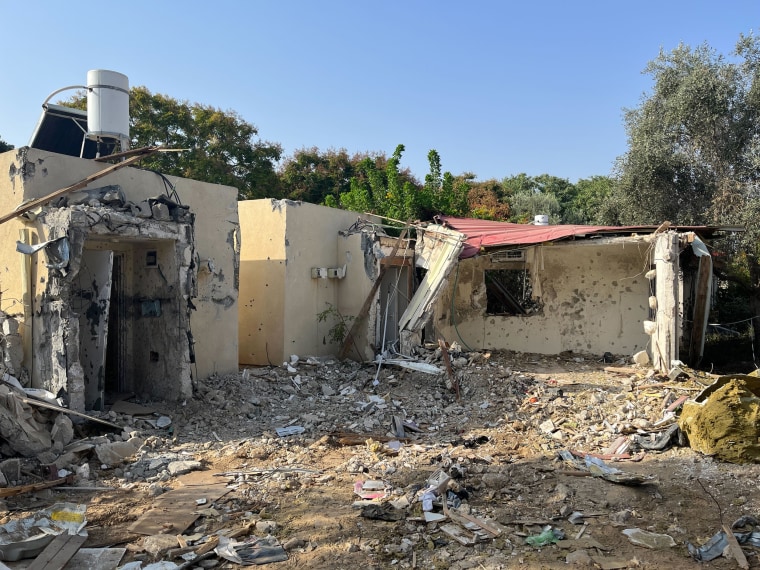
It was here that 260 people were killed trying to escape from the nearby Supernova music festival, and five of the roughly 600 kibbutzniks themselves were killed in the rampage.
Despite the chaos surrounding them, around 10 kibbutz residents have come back, determined to repair tractors, water crops — mainly potatoes and carrots — and begin to clear the debris, including militants’ boots and fatigues and AK-47 bullet casings that still litter the streets.
There are also more quotidian jobs that need attention — Mark said he needed to feed the family cat.
The returnees are far outnumbered by the dozens of troops whose armored personnel carriers have transformed this agrarian community into a military outpost.
It’s a village of charcoal buildings, mounds of crumbled concrete and walls studded with bullet holes. One home was bulldozed by the IDF while the militants were still inside, as witnessed by Mark. And the 15 days since are not enough to erase the fetid smell of death that hangs near some charred windows and door frames.
It’s clear he is still processing what he found: walking into a home and seeing four women, naked, and a boy, all killed, learning from the horrifying aftermath and eyewitness accounts that one of his friends had died trying to fight off the militants with his bare hands, and finding after the battle that partygoers from the nearby festival had been herded into a narrow area — “like cattle” —so they could be gunned down more efficiently.
On vacation in Slovenia when the attack started, he rushed back and joined the gunfight against Hamas the same evening. He is something of an unlikely warrior, his black body armor and automatic rifle juxtaposed with a pair of boot-cut blue jeans and white sneakers, an otherwise standard uniform for a dad of three in his 60s.
“This was not an army; an army fights like warriors,” Mark said. “They had instructions to make a horror that everybody would remember.”
Israel is a country experiencing several competing emotions: sorrow for the 1,400 people killed, anxiety for the 200-plus still held hostage and, for many, a desire to show resilience and strength after another massacre of Jews simply for being Jewish. Some yearn for what they see as justice and perhaps even vengeance, often coupled with dismay at what they view as insufficient sympathy in the West because of Israel’s relentless bombardment of Gaza.
But the attack has potentially unique ramifications for the kibbutzim, the collective farming communities that found themselves helpless on the front lines of Hamas’ killing spree.
This movement has a unique if endangered place in the nation’s psyche. Founded on socialist principles, it was key to the Zionist project and the foundation of the state of Israel.
Many of the communities' members reject the idea of building settlements in the occupied West Bank, which the United Nations says are illegal under international law. But they faced strong headwinds long before Oct. 7, with an increasing number becoming privatized, members’ wages languishing and their politics’ being marginalized as Israel lurched to the political right.
In nearby Be’eri, where more than 100 people were killed, the kibbutz is largely devoid of human life aside from dozens of soldiers who have set up camp there. Here, soldiers say, nobody has returned to live.
‘None were spared’
Yarnin Peled, a photographer who survived Hamas’ attack on Be’eri, returned to document the carnage and the slivers of a shattered life that residents left behind.
Peled, 55, who also works at a sports complex in Tel Aviv, survived Hamas’ attack with his partner, Dafna, by hiding in an upstairs shelter with their dog, Phoebe (named after the singer Phoebe Bridgers). They hid for more than 16 hours as militants tore through his community outside, killing neighbors, including Peled’s older sister, Maya, and her husband.
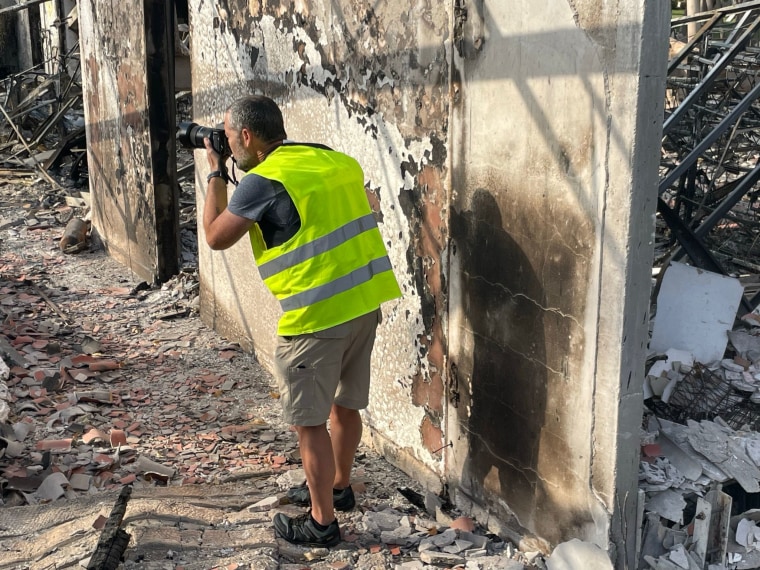
The couple sat in terror not just for themselves but also for one of his daughters, 19-year-old Yahel, who was safely hiding in a room in her home nearby.
Others are believed to have been taken hostage.
“None were spared, and that, for me, is the thing that makes me the most furious,” Peled said. The only way they and other residents could communicate with one another was over text. “Every part of the kibbutz” was “crying for help,” he said.
Be’eri was one of a handful of settlements in the Negev desert region and the south to be founded on Oct. 6, 1946, exactly 77 years and a day before Hamas’ attack, according to the Jewish Virtual Library, which is run by the American Israeli-Cooperative Enterprise, a nonprofit group aimed at strengthening the U.S.-Israel relationship. While field crops and fruits are grown on the kibbutz, its primary source of income is and has long been its printing press, which Peled said is also a big part of the community’s identity.
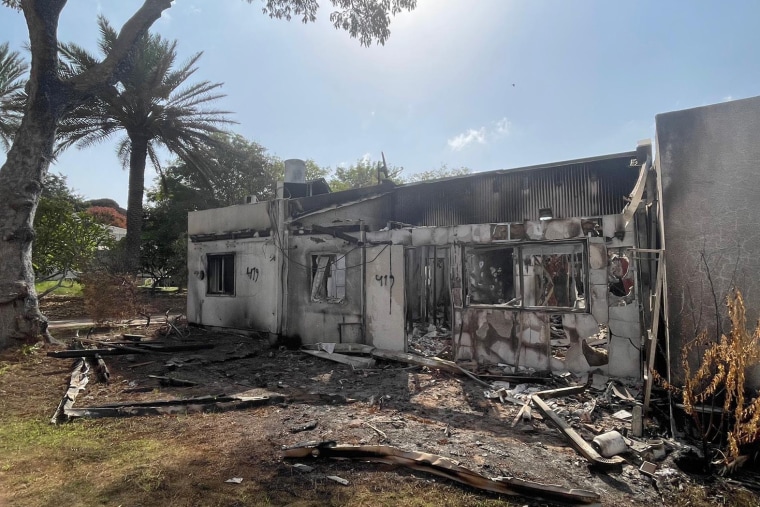
The smell of death that hung heavy in the air in Be’eri has dissipated, and the body bags have been cleared. But the devastation brought to this close community, where about a tenth of the population were killed, is palpable.
Those homes not burned or destroyed sit empty, with food left on the table starting to decay. Dozens of bicycles, the primary means of getting around here, lie charred on the ground. The few cars and trucks are smashed, doors wide open.
A soldier stationed in Be’eri, Staff Sgt. Ben Hardin, said that around 100 residents had visited the kibbutz since the attack to gather items left behind in the chaos.
“A lot of people aren’t ready to come back” more permanently, he said, though he believes they will “want to come back eventually.”
Hardin, who grew up in Los Angeles before he came to Israel, said he had always dreamed of living on a kibbutz and hoped Be’eri could be restored to the community it once was.
As he documented the destroyed homes of his friends and family and the now-barren places where the community used to gather, Peled said Be’eri was a place where the community truly cooperated.
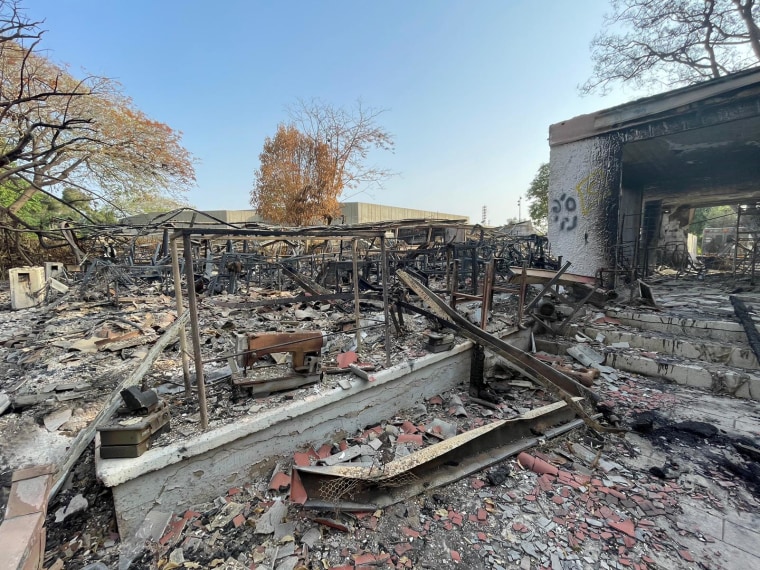
Representing much of what remains of Israel’s progressive and left wings, many who lived in places like Be’eri and Re’im were willing to negotiate and reach out to Palestinians.
“People here actually wanted the best for everybody, including people in Gaza,” Peled said.
Of those facing Israel’s ongoing bombardment, he said: “I feel for them … but I’m furious at the other end.”
He hopes to return as soon as possible to his home, where plants are withering and fruit is decaying in bowls. But fish still dart and sway in his small pond’s murky waters.
Peled is unsure whether fellow residents will follow his lead and try to rebuild the life they shared before Oct. 7.
“I’ll be back in a heartbeat if it’s up to me,” he said. But for others, “this is not a time to decide yes or no.”
Alexander Smith reported from the Re'im kibbutz and Chantal Da Silva from the Be'eri kibbutz.
